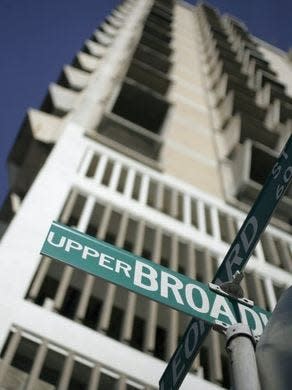The apartments planned for downtown's 600 Building are still in the works. Here's why.
It's among the tallest buildings on the downtown skyline, and its 21 stories may become more than 100 apartment units. The 600 Building at 600 Leopard St. stands empty for now, but the project remains in the works.
Originally pitched to city officials in 2016, it’s planned that construction at the 600 Building will get underway this year.

The launch of that work was pushed back by a series of COVID-19-related delays – including supply chain issues, inflation and disruption of financing, said developer Marcel Wisznia, a Corpus Christi native who now heads an architecture and development firm in New Orleans.
Costs to repurpose the building – which will include removing all of the interiors, replacing walls and installing new plumbing and electrical components, as well as elevators – rose by about 30%, Wisznia said, bringing the total for construction to an estimated $36 million.
There is a market for downtown living units, he said, and the company is committed to seeing the development plans through.
“We think the future of Corpus Christi is brighter than it was than even two, three, four, five years ago,” Wisznia said. “So our dream is still intact, we’re just dealing with day-to-day realities.”
Located at 600 Leopard St., the office tower was constructed in the 1960s.
Plans call for the conversion of the tower’s existing office space to 126 new apartment units, with five penthouse suites on the top story and commercial space on the ground floor, Wisznia said.
A reimbursement agreement with the city includes tax incentives totaling as much as about $4.6 million.
The figure accounts for a grant of about $3.27 million and about $1.25 million in property tax relief over a 10-year period, Wisznia said.
The funding supporting the agreement is drawn from tax increment revenue collected within a zone downtown. It can only be used within those geographical boundaries.
City Councilman Everett Roy said he was surprised the project – pitched while he was a city councilman in 2016 – hadn’t been completed when he returned to his position in January.
Still, he noted, because of the pandemic “there’s a lot of projects out there that have slowed down,” Roy said.
“It’s a building that has some architectural significance – I would like to see it rehabbed,” Roy said. “I think it would be a nice addition to what we’ve done downtown and would serve a purpose with additional living space, which is needed.”
The project will represent a “catalytic and game-changing evolution for Corpus Christi,” wrote Downtown Management District Executive Director Alyssa Barrera Mason in an email to the Caller-Times.
The organization is directly involved with downtown development.
A historic rehab and conversion project, it “will elevate the entire concept of what is possible for developers in Corpus Christi,” she wrote.
It’s estimated the project will take about 18 months to construct, once the work begins, Wisznia said.
He believes the development model could be the answer to the questions posed in an era of work from home.
“What is the future of the office tower – and if it’s not conventional offices, what do you do with these buildings to keep them from just going empty, being vacant?” he said. “…Repurposing of the office tower for uses like multifamily or hospitality, we’re going to see much more of.”
More: #TBT: Corpus Christi built its first skyscraper in 1927
More: Corpus Christi native Wisznia buys iconic 600 Building, plans for 131 modern apartments
More: What is Corpus Christi's Tax Increment Reinvestment Zone #3?
This article originally appeared on Corpus Christi Caller Times: Why Corpus Christi's 600 building has no apartments yet
